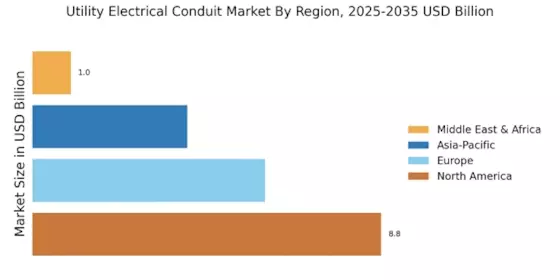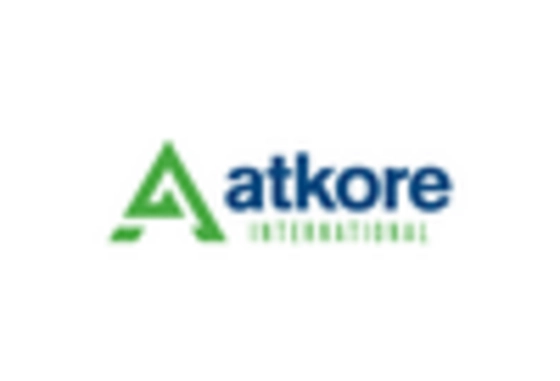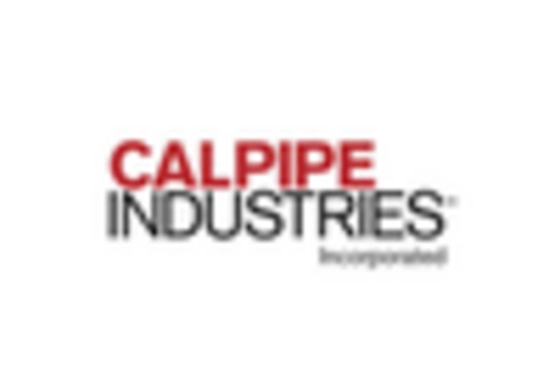Rising Demand for Renewable Energy
The increasing emphasis on renewable energy sources is driving the Utility Electrical Conduit Market. As countries strive to meet energy transition goals, the installation of solar panels and wind turbines necessitates robust electrical conduits for efficient energy distribution. In 2025, the renewable energy sector is projected to account for a substantial share of new electrical installations, thereby boosting demand for conduits. This trend is further supported by government incentives aimed at promoting clean energy solutions, which are likely to enhance the market for utility conduits. The integration of renewable energy systems into existing grids requires specialized conduits that can withstand various environmental conditions, indicating a potential growth area for manufacturers in the Utility Electrical Conduit Market.
Infrastructure Development Projects
Infrastructure development projects are a primary driver of the Utility Electrical Conduit Market. With urbanization on the rise, there is a pressing need for modernized electrical systems in both residential and commercial sectors. In 2025, investments in infrastructure are expected to reach unprecedented levels, particularly in developing regions. This surge in construction activities necessitates the installation of electrical conduits to ensure safe and efficient power distribution. Furthermore, government initiatives aimed at enhancing public infrastructure, such as transportation and utilities, are likely to create additional demand for conduits. The Utility Electrical Conduit Market stands to benefit significantly from these developments, as they require durable and reliable conduit solutions to support extensive electrical networks.
Increased Focus on Energy Efficiency
The increased focus on energy efficiency is a significant driver of the Utility Electrical Conduit Market. As energy costs continue to rise, both consumers and businesses are seeking solutions that minimize energy consumption. In 2025, energy-efficient electrical systems are expected to gain traction, leading to a higher demand for conduits that facilitate optimal energy distribution. This trend is further supported by government initiatives promoting energy-saving technologies, which are likely to encourage the adoption of advanced conduit systems. The Utility Electrical Conduit Market may see a shift towards products designed to enhance energy efficiency, thereby appealing to environmentally conscious consumers and businesses alike. This focus on sustainability could reshape product offerings and market strategies in the coming years.
Regulatory Compliance and Safety Standards
Regulatory compliance and safety standards are increasingly influencing the Utility Electrical Conduit Market. Governments worldwide are implementing stringent regulations to ensure the safety and reliability of electrical installations. In 2025, adherence to these regulations is expected to drive demand for high-quality conduits that meet specific safety criteria. Manufacturers are likely to invest in research and development to create conduits that comply with these standards, thereby enhancing their market competitiveness. Furthermore, the growing awareness of electrical safety among consumers is prompting utility companies to prioritize the use of compliant conduits in their projects. This trend indicates a potential growth opportunity for the Utility Electrical Conduit Market, as companies seek to align their products with evolving regulatory frameworks.
Technological Innovations in Conduit Manufacturing
Technological innovations in conduit manufacturing are reshaping the Utility Electrical Conduit Market. Advances in materials science have led to the development of conduits that are not only more durable but also lighter and easier to install. In 2025, the introduction of smart conduits equipped with sensors for monitoring electrical flow is anticipated to revolutionize the market. These innovations could enhance safety and efficiency in electrical installations, making them more appealing to contractors and utility companies. Additionally, the adoption of automation in manufacturing processes is likely to reduce production costs, thereby making conduits more accessible. As a result, the Utility Electrical Conduit Market may experience a shift towards more technologically advanced products that meet the evolving needs of consumers.


















Leave a Comment